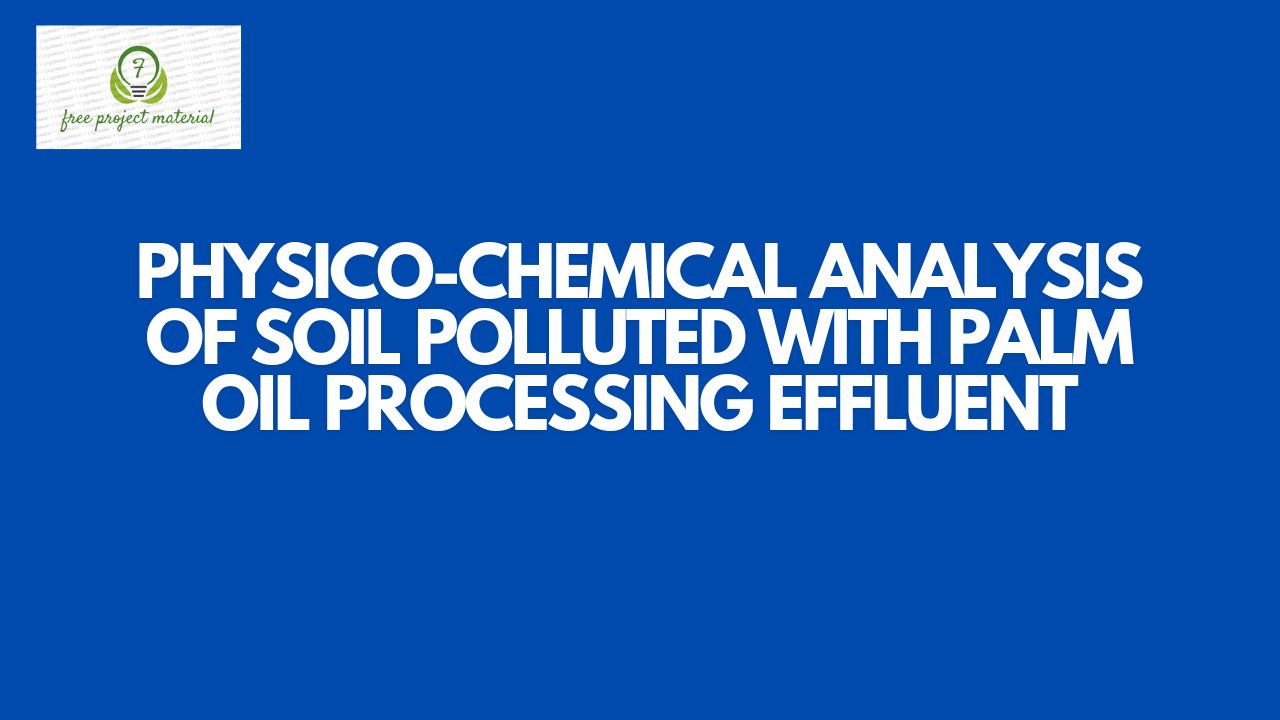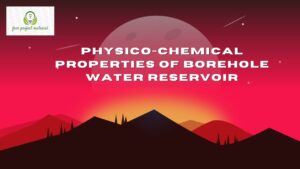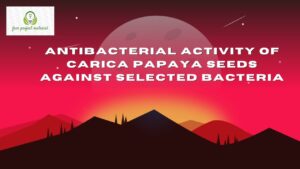ABSTRACT
This study was aimed at investigating the effect of Palm Oil Mill Effluent (POME) on the physico-chemical properties of the soil. Standard analytical methods and procedures were implemented in analyzing the samples that were collected from a local palm oil mill site in Ibiono Ibom Local Government Area. The result of the study revealed that the POME altered all the physico-chemical properties of the soil samples. It was concluded that proper use and safe disposal palm oil mill effluent could lead to improve soil fertility. Therefore, it is recommended that the POME should undergo proper treatment or decomposition before disposal in order to forestall the issue of pollution in the environment.
TABLE OF CONTENTS
Title Page – – – – – – – – – i
Certification – – – – – – – – ii
Dedication – – – – – – – – – iii
Acknowledgements – – – – – – – iv-v
Abstracts – – – – – – – – – vi
Table of Contents – – – – – – – – vii-ix
CHAPTER ONE: INTRODUCTION
1.1 Background of the Study – – – – – – 1-4
1.2 Problem Statement – – – – – – – 4
1.3 Aim and Objectives of the Study – – – – 4
1.3.1 Aim – – – – – – – – – 4
1.3.2 Objectives – – – – – – – – 5
1.4 Scope and Limitation of the Study – – – – 5
CHAPTER TWO: LITERATURE REVIEW
2.1 Impact of Palm oil mill effluent on soil quality – – 6-8
2.2 Potential options for palm oil mill effluent – – – 8-12
2.3 Bioremediation of palm oil mill effluent polluted soil – 12-14
2.4 Conversion of POME to value added products – – 15-16
2.4.1 Bioplastic Formation – – – – – – 16-18
2.4.2 Bioethanol Production – – – – – – 18-20
2.4.3 Citric Acid Production – – – – – – 21-22
2.5 Physico-chemical Properties in Soil Quality – – – 22
2.5.1 pH – – – – – – – – – 22
2.5.2 Texture – – – – – – – – 22-23
2.5.3 Moisture – – – – – – – – 23
2.5.4 Soil Temperature – – – – – – – 23
2.5.5 Electrical conductivity – – – – – – 24
2.5.6 Nitrogen – – – – – – – – 24
2.5.7 Phosphorus – – – – – – – – 25
2.5.8 Potassium – – – – – – – – 25
2.5.9 Soil Organic Matter – – – – – – 25-26
CHAPTER THREE: MATERIALS AND METHODS
3.1 Materials – – – – – – – – 27
3.2 Method – – – – – – – – 27
3.2.1 Sample Collection and Preparation – – – – 27
3.2.2 Determination of Physico-chemical Properties of the Soil – 27-28
3.2.2.1 Determination of Particle size and pH distribution – – 28
3.2.2.2 Determination of Organic Carbon and Total Nitrogen – 28
3.2.2.3 Determination of Phosphorus and Electrical Conductivity – 29
3.2.2.4 Determination of Exchangeable Acidity – – – 29
3.2.2.5 Determination of Exchangeable Cations, Calcium,
Sodium and Potassium – – – – – – 30
3.2.2.6 Determination of Exchange Capacity (ECEC)
and Base Saturation – – – – – – 31
CHAPTER FOUR: RESULTS AND DISCUSSION
4.1 Results – – – – – – – – 32-34
4.2 Discussion – – – – – – – – 34-38
CHAPTER FIVE: CONCLUSION AND RECOMMENDATION
5.1 Conclusion – – – – – – – – 38
5.2 Recommendation – – – – – – – 38
References
CHAPTER ONE
INTRODUCTION
1.1 Background of the Study
Environmental issues are increasing becoming more important globally. Over the recent years, there has been an activities associated with extraction, hydrocarbons, food processing, transportations and refining (Sethupathi, 2004). Industries have increased the threat of oil pollution to the environment and concomitant effluent discharged into the natural environment had created major ecological problem throughout the world. Discharge and indiscriminate dumping of palm oil mill effluent (POME) has led to alterations over time on soil physico-chemical characteristics (Ujang and Salim, 2010). Palm oil is one of the many vegetable oils widely consumed around the world. Oil palm production in Nigeria has risen from 8.2 in 1990 to 9 million in 2001 (Poku, 2002).
Nigeria is currently the 5th world’s leading producer of palm oil (Nnorom, 2012). The palm oil industry is a major agro based enterprise in Nigeria especially in the southern part of the country where palm oil trees are found both in the wild and plantations (Nwaugo et al., 2008).
Palm oil processing is carried out using large quantities of water in mills where oil is extracted from the palm fruits. About 40-45% of this is always a mill residue in the form of empty fruit bunches (EFB), shell, fibre and palm oil mill effluent (POME), which mill continue to accumulate with increasing production (Alrawi et al., 2013). The production of palm oil requires large volumes of water with concurrent generation of waste water known as palm oil mill effluent (POME). The POME is a mixture of water, oil and natural sediments (solid particles and fibres), large quantities of which are generated annually during crude palm oil production (Salihu and Alam, 2012) and is amenable to microbial degradation. It is estimated that for each tonnes of crude palm oil (CPO) that is produced 5-7.5 tonnes of water are required and more than 50% of this water (about 3.5 m3) ends up as POME (Nwoko et al., 2010).
The management of agro industrial effluents such as palm oil mill effluent (POME) has been a major environmental concern in countries producing them. These effluents are land and aquatic pollutants when discharged untreated, due to the presence of high organic load. Also, their phytotoxic properties are serious nuisance when discharged untreated, as they have high levels of organic loads and some organic acids. These effluent streams are normally disposed of in drainage channels or stored in evaporation ponds or worse still discharged in arable lands to possibly avert the cost treatment (Ibrahim et al., 2012; Ogunyemi et al., 2010).
This practice is predominant in developing countries where effluent discharged standards are not strictly adhered to. It has been observed that most of the POME produced by the small-scale traditional operators undergoes little or no treatment and is usually discharged into the surrounding environment. There is a dearth of information on these POME sediments.
The characterization of these sediments and their effects on the land or water body into which they are dumped are important for future researches due to the fact that these properties have significant effects on the settling process that occurs either under natural gravity or by coagulations (Okwute and Isu, 2007).
1.2 Problem Statement
The people of Ibiono Ibom L.GA. of Akwa Ibom State have been into the business of palm oil processing as one of their major occupations. Often the processed effluents are discarded indiscriminately into the environment without proper treatment. In recent times the physico-chemical composition of soil polluted with palm oil processing effluent has not been investigated. Therefore this study became imperative so as to known the impacts or otherwise of the palm oil processing effluent on fertile soil.
1.3 Aim and Objectives of the Study
1.3.1 Aim
The aim of this research project is to analyzed the physico-chemical analysis of soil polluted with palm oil processing effluents.
1.3.2 Objectives
The objectives of this research project includes;
- To analyzed the physico-chemical analysis of soil polluted with palm oil processing effluent
- To compare the result of this analysis with physico-chemical standard and with the work of other researchers.
- To make recommendations in suggestion for further studies base don the result obtained from this analysis.
1.4 Scope and Limitation of the Study
The design of this research project is to investigate and analyzed the physico-chemical analysis of soil polluted with palm oil processing effluent. Due to time, inadequate facilities and financial issues. This present research was limited to physico-chemical analysis of soil polluted with palm oil processing effluent.



